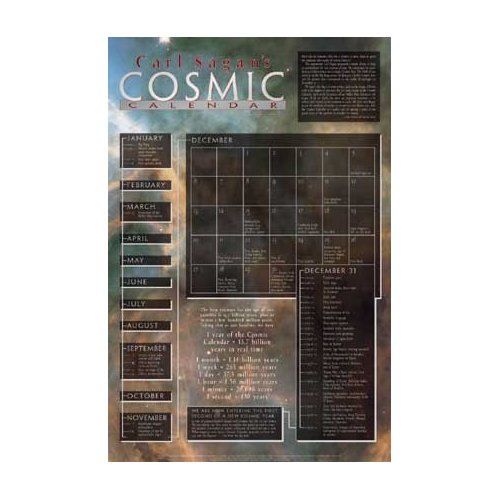
Approximate dimensions: H:36” W:24"
Pomegranate Communications;
original version published in The Dragons of Eden (1977 Carl Sagan)
Images from NASA and The Hubble Heritage Team (STScl); Designed by Mariah Lander.
How can we humans, who live a century at most, hope to grasp the immense time scales of cosmic history?
The astonomer Carl Sagan proposed a simple device to help us comprehend the vast expanse of time. He condensed the entire history of the cosmos into a single Cosmic Year. The birth of our universe in the Big Bang occurs on January 1 in the Cosmic Year, and the present time corresponds to the stroke of midnight on December 31.
We know the dates of some events, such as the origin of Earth, with a fair degree of accuracy. But for most events in the Cosmic Calendar, such as the formation of the Milky Way Galaxy, or the origin of life on Earth, the dates are imprecise estimates, to be refined and revised as we continue to learn. We have only begun to use the methods of science to reconstruct our distant past. Still, the Cosmic Calendar is a useful tool for getting a sense of the grand story of the universe as revealed by science.
The best estimate for the age of our universe is 13.7 billion years, plus or minus a few hundred million years. Taking that as our baseline, we have
1 year of the Cosmic Calendar = 13.7 billion years in real time
1 month = 1.14 billion years
1 week = 263 million years
1 day = 37.5 million years
1 hour = 1.56 million years
1 minute = 26,000 years
1 second = 430 years
JANUARY
- 1
-
12:00 a.m. Big Bang
12:15 a.m. Neutral atoms form; space becomes transparent - 6 First stars ignite
- 26 First galaxies form
FEBRUARY
MARCH
- 13 Formation of the Milky Way Galaxy
APRIL
MAY
JUNE
JULY
AUGUST
SEPTEMBER
- 1 Origin of our solar system and Earth
- 16 Oldest surviving rocks on Earth
- 21 First stirrings of life
- 29 Oldest stromatolites
OCTOBER
NOVEMBER
- 8 Significant oxygen atmosphere
- 30 Invention of sex by multicellular algae
DECEMBER
- 5 Seaweed appears
- 11 First amoebas with shells
- 15 Multicellular animals (e.g., sponges and jellyfish) appear
- 17 Cambrian explosion; first hard-bodied organisms
- 18 First fish
- 19 Algae begin to live on the land
- 21 First land animals (millipedes)
- 22 First sharks; first flying insects, ferns, and plants with roots
- 23 Rise of amphibians
- 24 First reptiles
- 25 Permian mass extinction; age of dinosaurs begins; first bees and mammals
- 26 First birds
- 28 First flowering plants; Africa separates from South America
- 30 Impact ends Cretaceous period; dinosaurs become extinct; first rodents, horses, grasslands
- 31
-
1:00 a.m. Primitive apes
12:00 p.m. Early dogs
2:00 p.m. Asteroid makes Ries crater in Germany
6:00 p.m. Early cats
9:00 p.m. First hominids
10:30 p.m. Stone tools
11:00 p.m. Domestication of Fire
11:48 p.m. Symbolic language
11:54 p.m. Homo sapiens appears
11:58 p.m. Seafarers settle Australia
11:59 p.m. Extensive cave paintings
11:59:37 p.m. Invention of Agriculture
11:59:46 p.m. Rise of Sumer
11:59:48 p.m. Bronze Age begins; writing invented
11:59:51 p.m. Code of Hammurabi in Babylon; Middle Kingdom in Egypt
11:59:52 p.m. Moses leads enslaved Hebrews out of Egypt
11:59:53 p.m. Trojan War; Olmec culture; Iron Age; Carthage founded
11:59:54 p.m. Founding of Rome; Ashokan India; Chin dynasty; Periclean Athens; birth of Buddha
11:59:55 p.m. Euclidean geometry; Archimediean physics; Ptolemaic astronomy; birth of Jesus
11:59:57 p.m. Zero and decimals invented in India; Muslim conquest
11:59:58 p.m. Mayan civilization; Sung Dynasty China; Byzantine Empire; Mongol invasion; Crusades
11:59:59 p.m. Copernicus; voyages of discovery; emergence of experimental method in science